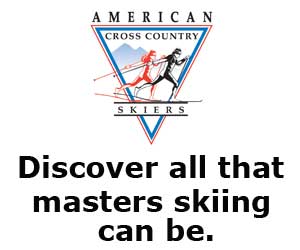
White Pine Stampede – Sometime in the Winter of 1977
The First Edition
Tue, Jan 10, 2006 - By Ernie Brumbaugh
As I remember it, I drove up to Kalkaska on day night because I couldn’t find a room in Mancelona. It was pretty darn cold. I was nervous with anticipation because having never done a ski marathon much less a ski race before. The previous year I tried and failed to get someone to go to the fourth Birkebeiner with me in Telemark, Wisconsin. “Why would you want to race on cross-country skis? Skiing is a peaceful sport.” 1977 was going to be my year regardless. I had booked a flight to Minneapolis already. Both the White Pine Stampede and the North American Vasa came into existence that year, so I had signed up for both races.
Saturday morning, it was up early, donning cotton knickers, knicker socks, fishnet underwear and a flannel shirt. My equipment consisted of three pin bindings, aluminum poles and 60 mm wooden skis, freshly pine-tarred and waxed tip to tail with a cold kick wax, Swix Polar for a base. I checked into the race headquarters in Mancelona, left my gear in the car and boarded an unheated bus headed for the start in Frederic, Michigan. I remember wondering if I would ever see my clothes again. As I recall we nearly froze on the way over to the start some 30 miles away.I was seated next to John Paul from Ann Arbor, who had on a black and white knicker ski suit and wooden racing skis (thin ones, Jarvinen I think). I was impressed, this guy must know what he is doing, I thought, probably never see him until the awards ceremony. His brother, Kevin, a teenager and still in high school was seated beside him.
The start area was pretty soft having been groomed with a snowmobile and it was windy. I fine turned the kick wax with Vauhti kick wax from my wax kit carried for the race in my fanny pack. I am pretty sure there was a survival kit in there also but I never needed it. The compass would come in handy in subsequent Stampedes. Ol’ Gus was there on a snowmobile telling us all the cautions that one should observe in a ski marathon. We lined up, he shot off the gun, got on his snowmobile and was off to set track ahead of us. About 100 skiers were beginning an adventure to be remembered. It was 17F and the winds built during the day to about 40-mph.
We skied along over hill and dale on fairly decent tracks. Back then ski races were about the only places that actually set tracks and the skiing was always fantastic compared to places like Muncie Lakes or the Pigeon River trails. Trying to make downhill turns on three pins bindings was interesting, when your heel kept slipping off the heel plate. You stepped a lot and only a little at a time, or set up in a snowplow early and prayed a lot.
As I said skiing was pretty good until we ski up to a wall. I don’t mean a Vasa type wall. I mean a looking-up-to-the sky sidestepping wall. About halfway up we observed ol’ Gus with the snow mobile and tracksetter pretty much buried in the snow. So much for the great tracks! It was a good thing someone up front knew the course because with only 100 skiers we really did not see that much of each other. At the top of that hill or one pretty soon thereafter we started a downhill with a turn in the middle of it in front of a pile of cement blocks. I was pretty glad to have made that turn!
After that we skied quite a few roads and there were plenty of officials directing us at the turn-offs. Must be people in Mancelona really wanted something to do in the wintertime. Standing out in the cold wind in February exuding all kinds of enthusiasm and exuberance has become a tradition for volunteers at the White Pine. I had confidently stored a candy bar in my shirt pocket for that extra energy boost in the later stages of the races and somewhere around 30-35 K I decided to partake of it. Candy bars get pretty hard in that temperature and I almost broke a tooth. Rather than waste energy sucking on it I tossed it aside and decided to just make the next aid station. And who was at that next aid station? None other than that slick knicker suit and the skier in it, John Paul. His brother, Kevin, was right beside him and appeared to be having trouble. I gulped down some blueberry soup, or something red, maybe Jack McKaig remembers if it was blueberry soup. Blueberry soup was the traditional marathon drink at the Swedish Vasaloppet. Anyway John got out ahead of me and I just caught glimpses of him the rest of the way in. Kevin was pulled from the race by his parents. Tracy Hardin, their younger sister and last years Michigan Cup champion, wasn’t racing yet.
From here on to the next aid station the race crossed a series of cut over plains and the wind was wicked. The track would fill in with a skier only 150-200 yards ahead. I tried to keep up just so I wouldn’t get lost, another White Pine tradition in the early days that has since been nicely solved. My hands began to freeze up and my beard was encrusted with ice and frost as I skied into the last aid station. A ski patroller said I had frostbite and would have to pull out of the race. I think my word were something to the effect of no way, can’t remember if the f word was included, but it probably was. I did stop and warm my hands in the exhaust of a parked automobile. That didn’t work particularly well so I pushed on.
There were a few kilometers of flat on the top on the ridge just East of Mancelona and then the best and still best ever finish to a marathon I have ever seen, a 2-3 k downhill to the base lodge at the then Mt Mancelona. Not many volunteers were outside at the finish line; most were inside with the other finishers trying to get warm. I was surprised when they put a numbered medal around my neck and escorted me to the lodge. After a considerable time spent thawing out, I realized that I had medal number 11. That black and white knicker suit had medal number 9. I was pretty pleased. Only 40 for the original 100 starters finished that day and rumor had it that last one to finish was legally blind. We were bussed back to the school, changed clothes and drove over to an awards ceremony at a local restaurant.
Bob Kemp was the first winner of the White Pine Stampede in 4:59:20. He would go on to win at least one other time before moving to Cincinnati. Medal #2 went to Jan Stuhlman in 5:04:00. He still skis the White Pine, preferring the 20K classic division these days (he posted a 1:56:37 in 2004 and a 2:01:53 in 2005). Tom Sutter has medal #5 skiing in at 5:25:48. He posted a 20K freestyle finish in 2004 in 1:02:27 – still pretty darn fast 30 years later. Medal #8, Jim Monroe in 5:33:10. He skied a classic 50K in 2004 in 3:25:26. John Paul was ninth in 5:39:15. I was Medal #11 in 5:50:35. George Gambert crossed the line in as Medal #18 with a 6:02:05. He continues to ski the 50K classic posting 3:59:15 in 2004 and 3:33:25 in 2005. And Ray Landfair, Medal #40 in 1977 in 8:02:12 skied a 20K in 2004 in 1:23:50. Some of the other notables in that first race were Dennis Hansen, medal # 15, editor of the Michigan Trail Atlas finished in 5:54:09, Verlen Krueger, medal #24, ultra marathon canoeist finished in 6:18:55.
I was reminiscing about the first race with Jack McKaig not too many years ago and I remember him saying, “We were sure lucky that year, we could have killed someone out there.” I agreed. It is also a good thing that Jack and all of the volunteers stuck with the race. They are responsible for the stellar marathon it is today. They have kept the hills and flavor of the original “point to point” race, lost none of the enthusiasm of the volunteers, and upgraded just about everything else. Now it is a race from Mancelona High School – breakfast served practically at the start line – 50 kilometers to Shanty Creek Ski Lodge with showers and a cafeteria. They even provide day care services at the start line. In between, there are flats, screaming downhills and long exhausting uphills and plenty of enthusiastic volunteers all too ready and willing to boost you spirits and get you back on the trail. And the medals are still numbered sequentially some 30 years later. And most importantly nobody gets lost anymore. So if you ever get exasperated at a race official these days, think back to what it was in the beginning and realize just how far the sport has really come.
